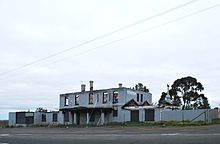
The Eureka Rebellion was a series of events involving gold miners who revolted against the British administration of the colony of Victoria, Australia during the Victorian gold rush. It culminated in the Battle of the Eureka Stockade, which took place on 3 December 1854 at Ballarat between the rebels and the colonial forces of Australia. The fighting resulted in an official total of 27 deaths and many injuries, the majority of casualties being rebels. There was a preceding period beginning in 1851 of peaceful demonstrations and civil disobedience on the Victorian goldfields. The miners had various grievances, chiefly the cost of mining permits and the officious way the system was enforced.

Castlemaine is a small city in Victoria, Australia, in the Goldfields region about 120 kilometres northwest by road from Melbourne and about 40 kilometres from the major provincial centre of Bendigo. It is the administrative and economic centre of the Shire of Mount Alexander. The population at the 2021 Census was 7,506. Castlemaine was named by the chief goldfield commissioner, Captain W. Wright, in honour of his Irish uncle, Viscount Castlemaine.
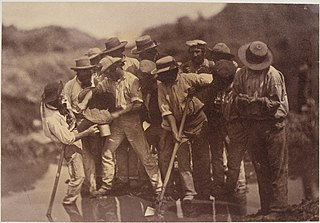
The Victorian gold rush was a period in the history of Victoria, Australia approximately between 1851 and the late 1860s. It led to a period of extreme prosperity for the Australian colony, and an influx of population growth and financial capital for Melbourne, which was dubbed "Marvellous Melbourne" as a result of the procurement of wealth.
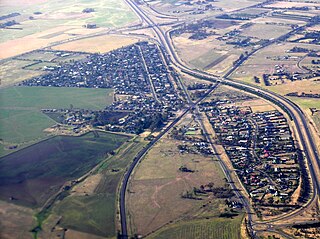
Diggers Rest is a suburb in Melbourne, Victoria, Australia, 33 km (21 mi) north-west of Melbourne's Central Business District, located within the Cities of Hume and Melton local government areas. Diggers Rest recorded a population of 5,669 at the 2021 census.

Calder Highway is a rural highway in Australia, linking Mildura and the Victoria/New South Wales border to Bendigo, in North Central Victoria. South of Bendigo, where the former highway has been upgraded to freeway-standard, Calder Freeway links to Melbourne, subsuming former alignments of Calder Highway; the Victorian Government completed the conversion to freeway standard from Melbourne to Bendigo on 20 April 2009.

The Victorian Goldfields Railway is a 1,600 mm broad gauge tourist railway in Victoria, Australia. It operates along a formerly disused branch line between the towns of Maldon and Castlemaine.

Maldon is a town in Victoria, Australia, in the Shire of Mount Alexander local government area. It has been designated "Australia's first notable town" and is notable for its 19th-century appearance, maintained since gold-rush days. At the 2016 census, Maldon had a population of 1,513.
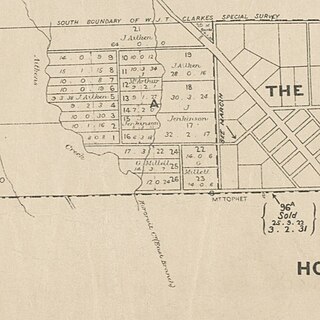
Buttlejorrk is a parish of the County of Bourke located to the west of Sunbury, in Victoria, Australia and a neighbourhood within the locality of Diggers Rest. It was named in 1839 by the surveyor William Darke. A township developed and was initially known as Aitken's Gap. By the 1890s it had commonly become known as Buttlejorrk. A Post Office opened on 5 September 1856 as The Gap, was renamed Buttlejork (sic) in 1875 and closed in 1919. One of the early settlers in the area was George Millett. George and his wife Suzanne established the Bald Hill Hotel, the first staging stop out of Melbourne on the road to the goldfields at Bendigo. The hotel was licensed in 1853 until 1907. The Aitken's Gap Gaol, now located in the forecourt of the Sunbury Police Station stood beside the hotel

Blackwood is a rural village in Victoria, Australia. The township is located on the Lerderderg River, 89 kilometres north-west of the state capital, Melbourne, within the Wombat State Forest. Blackwood is in the Shire of Moorabool local government area and had a population of 387 at the 2021 census.
The Ballarat Reform League came into being in October 1853 and was officially constituted on 11 November 1854 at a mass meeting of miners in Ballarat, Victoria to protest against the Victorian government's mining policy and administration of the goldfields.

James Macpherson Grant was an Australian solicitor who defended the Eureka Stockade rebels and a politician who was a member of the Victorian Legislative Assembly and the Victorian Legislative Council.
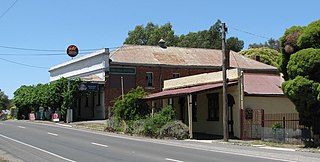
Chewton is a town in central Victoria, Australia in the Shire of Mount Alexander local government area, 116 kilometres north west of the state capital, Melbourne. At the 2016 census, Chewton had a population of 1313.
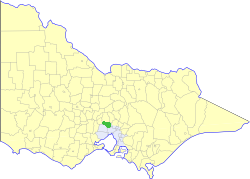
The Shire of Bulla was a local government area about 40 kilometres (25 mi) northwest of Melbourne, the state capital of Victoria, Australia. The shire covered an area of 422.17 square kilometres (163.0 sq mi), and existed from 1862 until 1994.

Campbells Creek is a town in Victoria, Australia.

The Shamrock Hotel, currently trading as Hotel Shamrock, is a grand 19th-century hotel in Bendigo, Victoria, Australia, situated on Pall Mall, the city's main street.

Timor (/ˈtaɪˈmɔː/), also known as Timor-Bowenvale, is a mainly rural area in the Central Goldfields Shire of Victoria, Australia. It is located 8 kilometres (5 mi) north of Maryborough, Victoria and 178 kilometres (111 mi) northwest of Melbourne, the state capital.

During the Australian gold rushes, starting in 1851, significant numbers of workers moved from elsewhere in Australia and overseas to where gold had been discovered. Gold had been found several times before, but the colonial government of New South Wales had suppressed the news out of the fear that it would reduce the workforce and destabilise the economy.
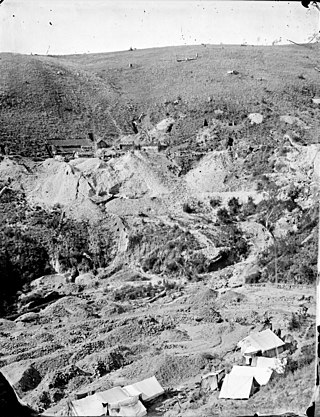
The Jim Crow goldfield was part of the Goldfields region of Victoria, Australia, where gold was mined from the mid- to the late-nineteenth century.
Strangways is a locality within the local government area of Mount Alexander, in Central Victoria, Australia. It covers an area of 20.105 square kilometres between the townships of Guidford to the east, Newstead to the north-west and Clydesdale to the south.
The following is a timeline of the Eureka Rebellion.
